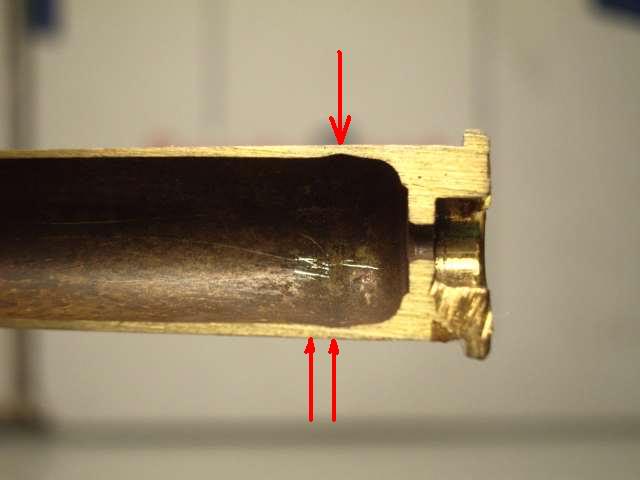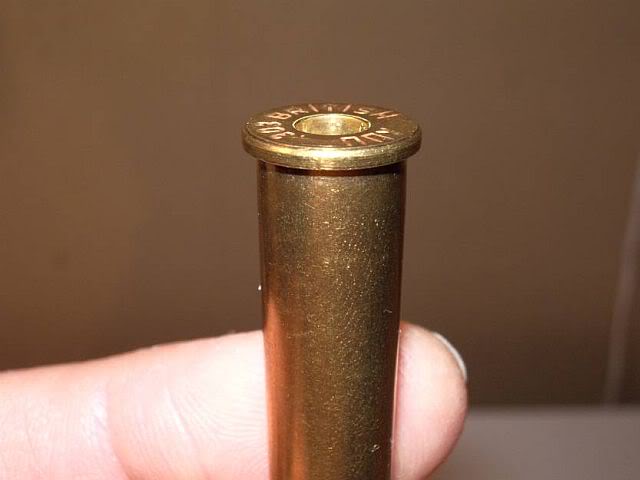-
Banned

Free Beer
1907 headspace change, does anyone know why?
Doesn't anyone have any reference material relating to this?
The headspace for the Enfield Rifle was changed in 1907 does anyone know why i.e. Boer War findings from field use, improvements in cartridge case design etc????????
was changed in 1907 does anyone know why i.e. Boer War findings from field use, improvements in cartridge case design etc????????
"Gauge, Armourers - Jul 9 1907, Distance of bolt from end of chamber, .074 inch.
All magazine rifles and carbine; rejecting gauge
Approval having been given to increase the rejecting limit of the distance between the face of the bolt-head and end of chamber of magazine arms in the hands of troops by .002-inch, a pattern of the above-mentioned gauge has been approved.
Officers commanding units and Ordnance officers in charge of depots, with an armourer attached, and Ordnance officers in possession of the reference gauges referred to in Appendix IV of the Equipment Regulations, Part I, 1906, will demand gauges of the new pattern and return the .072 gauge to store.
For Naval Service the rejecting limit will be as follows for rifles under examination and repair at Naval Ordnance depots ...................072 inch for rifles on board ships, &c.............074 inch
Supply of the gauges to ships &c., will be arranged by the Admiralty."
Information
 |
Warning: This is a relatively older thread
This discussion is older than 360 days. Some information contained in it may no longer be current. |
|
Last edited by Edward Horton; 01-12-2010 at 10:30 PM.
-
01-10-2010 10:05 PM
# ADS
Friends and Sponsors

-
FREE MEMBER
NO Posting or PM's Allowed

Maybe trying to reduce the attrition rate or the number of rifles being sent back for factory repair ?? the extra .002 would have kept quite a few rifles in service.
-
That's a very interesting observation Ed! I'll be following this.................
-
-
Legacy Member


Originally Posted by
Edward Horton

1907 headspace change, does anyone know why?
Doesn't anyone have any reference material relating to this?
The headspace for the
Enfield Rifle
was changed in 1907 does anyone know why i.e. Boer War findings from field use, improvements in cartridge case design etc????????
"Gauge, Armourers - Jul 9 1907, Distance of bolt from end of chamber, .074 inch.
All magazine rifles and carbine; rejecting gauge
Approval having been given to increase the rejecting limit of the distance between the face of the bolt-head and end of chamber of magazine arms in the hands of troops by .002-inch, a pattern of the above-mentioned gauge has been approved.
Officers commanding units and Ordnance officers in charge of depots, with an armourer attached, and Ordnance officers in possession of the reference gauges referred to in Appendix IV of the Equipment Regulations, Part I, 1906, will demand gauges of the new pattern and return the .072 gauge to store.
For Naval Service the rejecting limit will be as follows for rifles under examination and repair at Naval Ordnance depots ...................072 inch for rifles on board ships, &c.............074 inch
Supply of the gauges to ships &c., will be arranged by the Admiralty."
Tracking this change backwards gets original .303 headspace very close to current US SAAMI standards doesn't it? I have always suspected that current SAAMI specs are closer to the original dimensions than are current British standards.
standards.
Why? The .303 British was never a US military cartridge subjected to the British engineering changes. However it was a US commercial round subject to US industry standardization. Just because the British military needed to change did not mean there was any reason to change US commercial manufacturing practice.
Last edited by ireload2; 02-07-2010 at 05:21 PM.
-
-
Legacy Member


Originally Posted by
ireload2

Tracking this change backwards gets original .303 headspace very close to current US SAAMI standards doesn't it? I have always suspected that current SAAMI specs are closer to the original dimensions than are current
British
standards.
Why? The .303 British was never a US military cartridge subjected to the British engineering changes. However it was a US commercial round subject to US industry standardization. Just because the British military needed to change did not mean there was any reason to change US commercial manufacturing practice.
So - when SAMMI was founded in 1926 (I think) they sat back and had a great debate :
"Shall we take the max headspace on a British 303 as that stated by the miltary prior to July 1907 (0.072"), or shall we take that used in July 1907 onwards, (0.074") no - lets take neither and invent our own (0.070")
0.072" is closer to 0.070" than 0.074" is, but there again, so is 0.068"
Mine are not the best, but they are not too bad. I can think of lots of Enfields I'd rather have but instead of constantly striving for more, sometimes it's good to be satisfied with what one has...
-
-
Banned

-
Legacy Member


Originally Posted by
Edward Horton

1907 headspace change, does anyone know why?
Doesn't anyone have any reference material relating to this?
The headspace for the
Enfield Rifle
was changed in 1907 does anyone know why i.e. Boer War findings from field use, improvements in cartridge case design etc????????
"Gauge, Armourers - Jul 9 1907, Distance of bolt from end of chamber, .074 inch.
All magazine rifles and carbine; rejecting gauge
Approval having been given to increase the rejecting limit of the distance between the face of the bolt-head and end of chamber of magazine arms in the hands of troops by .002-inch, a pattern of the above-mentioned gauge has been approved.
Officers commanding units and Ordnance officers in charge of depots, with an armourer attached, and Ordnance officers in possession of the reference gauges referred to in Appendix IV of the Equipment Regulations, Part I, 1906, will demand gauges of the new pattern and return the .072 gauge to store.
For Naval Service the rejecting limit will be as follows for rifles under examination and repair at Naval Ordnance depots ...................072 inch for rifles on board ships, &c.............074 inch
Supply of the gauges to ships &c., will be arranged by the Admiralty."

Originally Posted by
Alan de Enfield

So - when SAMMI was founded in 1926 (I think) they sat back and had a great debate :
"Shall we take the max headspace on a
British
303 as that stated by the miltary prior to July 1907 (0.072"), or shall we take that used in July 1907 onwards, (0.074") no - lets take neither and invent our own (0.070")
0.072" is closer to 0.070" than 0.074" is, but there again, so is 0.068"
When SAAMI was founded they adopted existing industry practice.
Why would they invent anything new?
From 1888 to 1926 the Brits were trying to make a black powder design work with smokeless. Since the 1907 change seems to be new here there is no guarantee it was the first and only headspace change. After all the Brits were in a constant cycle of engineering changes and came close to dumping the design in 1913-1914.
-
-
Legacy Member


Originally Posted by
Edward Horton

The SAAMI sets civilian cartridge and the chamber standards in the
United States
and the SAAMI did not come into being until 1926, the Lee Enfield rifle was officially adopted in 1895.
The SAAMI deals with commercial standards and doesn't even tell the American military how to set chamber and head space standards on military rifles.
Having said that I feel confident that the civilian American SAAMI wasn't going to tell the
British
military what the head space and chamber standards should be on the British Enfield rifle 31 years after the Enfield came into being.
It was a British Military decision to change the head space in 1907 and NOT the American SAAMI which would not come into being for another 19 years.
I was looking for historical British answers like improvements is .303 case design and manufacture or a new rifle was in the works and the head space was increased to extend the
Enfield Rifles
life cycle.
Considering that Winchester manufactured the 1895 Winchester rifle in .303 British, US commercial practice could not very well be changed regardless of where the British military went with their design standards.
As you may notice SAAMI is still around and the British military is out of the .303 business. There is a good chance that the .303 will remain actively standardized by SAAMI longer than it did in the British military.
-
-
Banned


Originally Posted by
Alan de Enfield

So - when SAMMI was founded in 1926 (I think) they sat back and had a great debate :
"Shall we take the max head space on a
British
303 as that stated by the military prior to July 1907 (0.072"), or shall we take that used in July 1907 onwards, (0.074") no - lets take neither and invent our own (0.070")
0.072" is closer to 0.070" than 0.074" is, but there again, so is 0.068"
Alan de Enfield.
You left out the part about the last time Americans told the British what to do they burned Washington D.C. in 1814. 
Let us also not forget American .303 cartridge cases designed by the SAAMI were NEVER designed to shoot in long fat British military .303 Enfield chambers...........
And my question "why" was the head space increased in 1907 has never been answered.
Below, a commercial American factory loaded Winchester case fired in an Lee Enfield with the head space set at .067, this case stretched and thinned over .009 thousandths in the web area on the first firing.

Below, a Serbian made Prvi Partizan case fired in the same Enfield, this case did NOT thin or stretch in the web area on the first firing.

Today, Lee Enfield head space is governed by "who" made the cases you shoot and not the rifle 
-
Legacy Member

There are more British spec rifles out there than there ever will be SAAMI spec rifles. SAAMI specs are wrong end of story.
spec rifles out there than there ever will be SAAMI spec rifles. SAAMI specs are wrong end of story.
-
Thank You to Bindi2 For This Useful Post:
was changed in 1907 does anyone know why i.e. Boer War findings from field use, improvements in cartridge case design etc????????















 Register To Reply
Register To Reply














